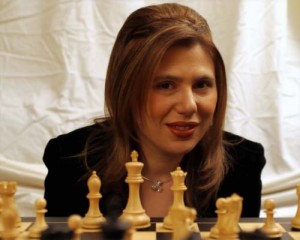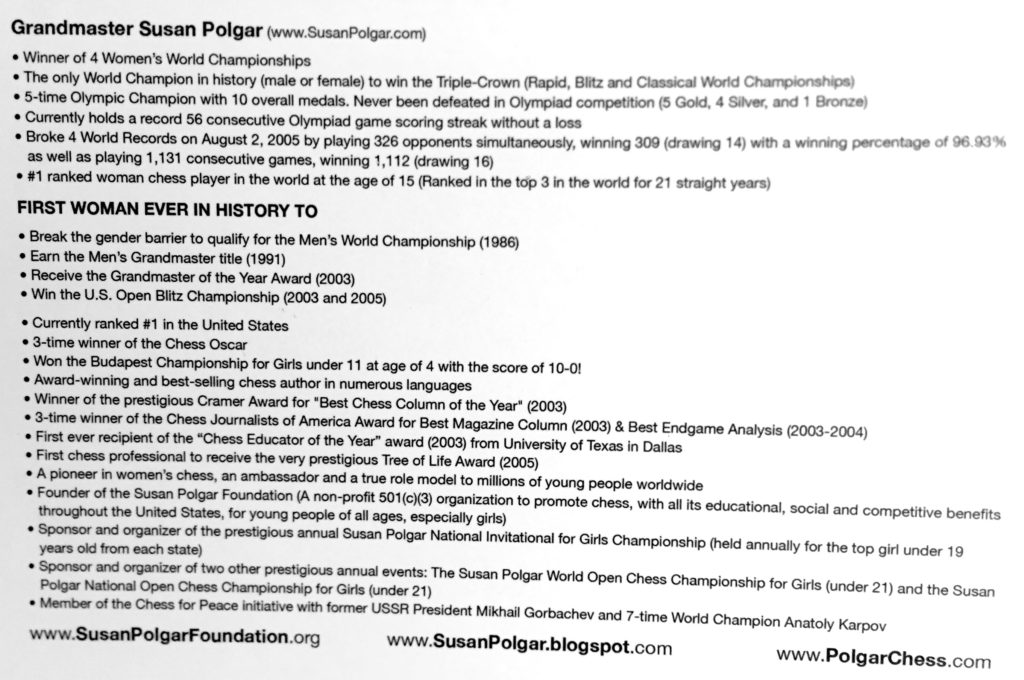Grandmaster Susan Polgar
Article from Forward.com: Original Article Here
The Real ‘Queen’s Gambit’:
Meet the First Woman to Qualify for
the World Chess Championship
PJ Grisar November 18, 2020
This article contains spoilers for “The Queen’s Gambit.”
When it comes to the real queen of chess — not the orphaned, sedative-addicted, fashionista variety now in vogue courtesy of Netflix’s “The Queen’s Gambit” — Susan Polgar is a model grandmaster.
Two decades after Beth Harmon took on the fictional Russian champion Vasily Borgov in Moscow, Polgar became the first woman to qualify for the Men’s Zonal World Chess Championship in 1986, when she was just 17. But the Hungarian-born Polgar’s ascent wasn’t nearly as easy or as cordial as the one depicted in miniseries.
“The sexism that she faced seems like it was a picnic compared to what I had to deal with in real life,” said Polgar, who, from the time she started competing as a toddler, perching on pillows to reach the board, had men and boys questioning her presence at tournaments.
When she was a teenager, a six-time U.S. Champion some 20 years her senior threw the chess pieces in her direction when he lost. Her life as a chess prodigy was rife with physical intimidation, emotional and mental abuse and, as she grew older, unwanted sexual advances. One constant of her career were the doubts, even from supporters, that a woman could ever compete with men on the highest level.
“I was stunned,” Polgar, 51, said from her home in St. Louis, Mo., where she coaches Webster University’s chess team. “Why? It’s not like a race where physical strength or speed would play the decisive role. This is just about thinking and about strategy and outsmarting your opponent. I promptly became determined to prove them wrong and actually used it as fuel to motivate myself to prove myself on the chess board.”
She did so by playing men — some decades older — when few other female players were doing so.
There was no Beth Harmon to pave the way for Polgar, who was barred by the Hungarian chess authorities from competing in the Men’s Championship on account of her gender and, quite possibly, because she is Jewish. Two women, the Soviet Union’s Nona Gaprindashvili and Maia Chiburdanidze, earned grandmaster titles by virtue of being women’s world champions, but their accomplishments weren’t on the level of Harmon’s obliteration of gender norms.
Polgar believes that the character of Harmon, first dreamed up for Walter Tevis’ 1983 novel, is a composite of Bobby Fischer, the eccentric American who beat the Soviet champion Boris Spassky, and Lisa Lane, the U.S. Women’s Champion who graced the cover of Sports Illustrated as part of a 1961 cover story.
“Lisa Lane never achieved anywhere near that kind of success, but she was glamorous and lived a, let’s say, active life like Beth Harmon did,” Polgar said.
More…

Susan Polgar, who became the top-ranked female chess player at age 15,
assesses the state of play. (Image by Courtesy of Susan Polgar)
Originally published on The Washington Post: Original Article Here
Five Myths About Chess
By Jennifer Shahade
Jennifer Shahade is a chess champion, author, poker player and Women’s Program Director at U.S. Chess.November 20, 2020 at 8:54 a.m. EST
Chess is having a moment. Chess is also having a decade. The game has been on an upward trajectory in pop culture ever since the charismatic Magnus Carlsen, who has even worked as a model, won the World Chess Championship in 2013. That same year, Congress declared St. Louis the country’s “chess capital.” Now Netflix’s “The Queen’s Gambit” has ratcheted interest up to new heights. As millions of converts download chess apps and buy boards, it’s time to dispel a few myths about this ancient game.
Myth No. 1
Chess is dull and unsexy.
“Does it seem to you like there just isn’t enough televised chesson these days?” David Letterman joked sarcastically in 1989. More recently, coverage of “The Queen’s Gambit” has expressed doubt about the visual and dramatic appeal of the game. Vanity Fair said that, to most people, the game seems “dull and buttoned-up.” And the Cut cried, “The Sexiest Show on Television Is About . . . Chess?”
The Netflix series plays up the royal game’s glamorous side and, yes, its sensual side. But the connection between chess and sex goes back centuries. Historian Marilyn Yalom writes that medieval artists — in manuscript illustrations, tapestries and stained-glass windows, among other art forms — treated the game as synonymous with seduction: “A chess scene between a man and a woman signified romance.” Yalom also describes a work of fiction from around 1400, called “The Book of Erotic Chess,” in which “each move on the board represented a decisive moment in the game of love” between the characters.
Today’s international chess competitions often feature just one game a day, in the midafternoon — leaving players with plenty of time to connect at drinks, long dinners and parties. Some enthusiasts have even compiled lists of the greatest “chess couples” to have “found romance over the 64 squares,” and who have a combined rating of over 5000 from the International Chess Federation (FIDE).

